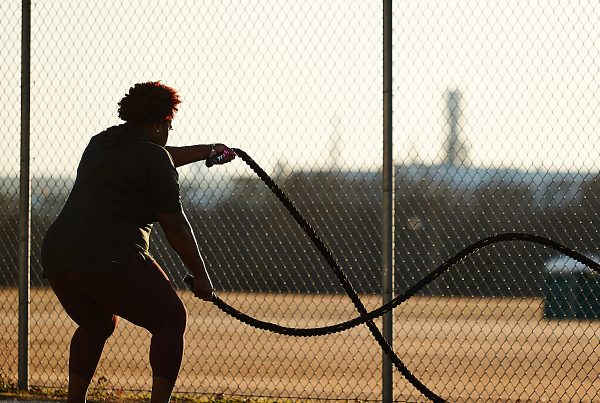No longer just for elite athletes, altitude training has gone mainstream – so how effective is it? Associate professor Mike Climstein and Joe Walsh explain.
Every endurance fitness enthusiast is interested in the next ‘new’ supplement or training technique that will further increase their maximal aerobic power, aka VO2max (maximal oxygen consumption). Altitude training, although not new in professional sport, has now entered the fitness enthusiasts’ commercial market for both health and fitness benefits. Yes, we said health benefits. We recently published a review paper on the health benefits of altitude training and found that it was associated with improvements in bodyweight, body composition (>1,700m altitude), improved fasting blood glucose (1,500-3,000m for > 21 days), improved resting blood pressure in hypertensive individuals (1,285-2,650m) and improved total cholesterol and low-density lipoprotein cholesterol. There is still plenty more work to be done in this area.
As we mentioned, altitude training for improved aerobic performance is not a new concept and, according to altitude expert at the Australian Institute of Sport Professor Chris Gore, “there is a 1-2% increase in performance, which mightn’t sound like much, but can be the difference between a medal and failing to qualify”. Altitude training refers to the use of normobaric or hypobaric hypoxia (i.e., reduced oxygen concentration, <20.93%) in an attempt to emulate altitude acclimatisation to attain improved endurance performance. Normobaric hypoxic training incorporates the use of masks, tents and chambers, whereas hypobaric hypoxic training involves ascending to elevated environments. Clearly, it is more cost effective to utilise chambers and the like when you are geographically disadvantaged to elevated environments.
Research review
Interestingly, altitude training originated as a result of noticeable decrements in performance that were associated with competition at altitude. However, Professor Burt in 1943 was the first scientist to notice that there were highly favourable alterations which occurred in muscle as a result of exposure to altitude. It took some 40 years to realise that environmental hypoxia could compound the normal physiological adaptations to endurance training and, in the mid-1980s, the scientific literature exploded with studies investigating the advantages and adaptations associated with altitude training.
Today, altitude training in professional sport in Australia is considered an integral aspect of training. Most professional sporting disciplines now use altitude chambers and a number of AFL footy teams travel to the US (Arizona or Utah) to live and train at altitude in order to derive an additional physiological benefit. Additionally, a number of rugby league teams have utilised altitude training systems to gain a drug-free advantage over competitors. It’s not surprising that altitude training has filtered down to fitness enthusiasts: here on the Gold Coast of Australia we have two commercial altitude training centres and business is booming.
Effects of high-intensity interval training in normobaric hypoxia on aerobic capacity
Authors: Dr Czuba et al (Jerzy Kukuczka Academy, Poland)
Source: Journal of Human Kinetics, Dec 2013 (ePub before print) (Available free online at ncbi.nlm.nih.gov/pmc/articles/PMC3916912/
Dr Czuba and his colleagues recruited 12 fit and healthy basketball players to participate in their study. Participants were divided into two groups, hypoxia (H) and control (C). The hypoxia training group completed their training in a hypoxic chamber which was set at a simulated altitude of 2,500m, which had an oxygen concentration of only 15.2%. At sea level, for example, the normal oxygen concentration is 20.93%. The control group also completed its training in the hypoxic chamber but at normal sea-level conditions. Both groups trained six days per week for three weeks, with each training session lasting 90-120 minutes with the intensity at ~90% of VO2max (five four-minute bouts). A warm-up (60% VO2max x 5mins, then 70% VO2max x 5mins) and cool-down (60% VO2max x 10mins) was provided to both groups for each training session. All participants were tested on a treadmill prior to initiating the training and immediately upon completion of three weeks of training.
Results
Following the three weeks of high-intensity interval training there were no significant differences between the two groups in terms of bodyweight, lean muscle mass or percentage of body fat. However, there was a significant improvement in the total distance ridden during the bike test (+10%) as well as power output (+4.5%) and VO2max (+7.8%) in the hypoxia group. This group also experienced a decrease in HRmax (-1.6%) and in peak lactate levels (9.6%).
Pros
These are promising results and lend support to the use of simulated short-term altitude training combined with high-intensity interval training for improved endurance performance, specifically VO2max.
Cons
Now that more commercial training facilities are installing altitude chambers, it will be interesting to see the improvements in endurance capacity by non-athletes. It would have been beneficial if the researchers had also measured haemoglobin, haematocrit and erythropoietin. Individuals considering trialling hypoxic training should first speak with their GP and, if deemed safe, should ensure they use a pulse oximeter during all hypoxic training sessions to monitor their degree of desaturation (i.e., a decrease in blood oxygen levels) in a professionally supervised environment, with suitably qualified individuals.
The 30-second recap
- Altitude training involves training at reduced oxygen atmospheres – real or simulated – in order to improve endurance performance.
- It has been associated with a number of health and fitness benefits.
- It has become widely used by many sporting disciplines and football codes and is gaining mainstream popularity.
- This athlete study linked altitude training to increased power output and VO2max, and reduced HRmax and peak lactate levels.
Associate Professor Mike Climstein, PhD FASMF FACSM FAAESS, is one of Australia’s leading accredited exercise physiologists. He is the programme director of clinical exercise science and co-director of the water-based research unit at Bond University’s Institute of Health & Sport. michael_climstein@bond.edu.au
Joe Walsh, MSc is a sport and exercise scientist. As well as working for Charles Darwin and Bond Universities, he is a director of Fitness Clinic in Five Dock, Sydney fitnessclinic.com.au
This article first appeared in Australian
Fitness Network, the leading title for fitness
professionals.







